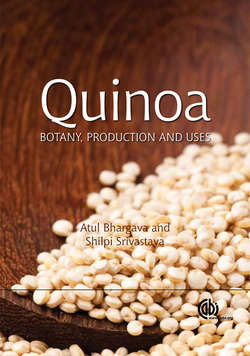Quinoa

Реклама. ООО «ЛитРес», ИНН: 7719571260.
Оглавление
Atul Bhargava. Quinoa
QUINOA
Contents
Contributors
Preface
Acknowledgements
1 Introduction
1.1 Underutilized Crops
1.2 Chenopodium as an Underutilized Plant
1.3 Quinoa
1.3.1 Nutritional importance of quinoa
1.3.2 Stress tolerance
1.3.3 Economic uses
1.3.4 Medicinal importance
1.4 Concluding Remarks
References
2 Historical Perspectives and Domestication
2.1 Introduction
2.2 General Process of Plant Domestication
2.3 Importance of the Genus Chenopodium and Domestication of C. quinoa
2.4 Current Insights into the Evolution of Genetic Diversity in Quinoa
2.5 Current Typology to Describe the Diversification and Utilization of the Quinoas in South America
2.5.1 Quinoas of the Altiplano (northern Andean highlands)
2.5.2 Quinoas from the Salares (southern highlands)
2.5.3 Quinoas from Inter Andean Valleys
2.5.4 Quinoas from arid zones and dry conditions (western highlands)
2.5.5 Quinoas from high altitudes and cool climate
2.5.6 Quinoas from the coastal regions and near the sea
2.5.7 Quinoas from jungle and tropical zones
2.5.8 Quinoa from high rainfall and humidity zones
2.5.9 Wild relatives of quinoa
2.6 Concluding Remarks
Acknowledgements
References
3 Distribution. 3.1 Introduction
3.2 The Andean Region and Quinoa
3.3 Quinoa in its Native Region
3.3.1 Bolivia
3.3.2 Peru
3.3.3 Chile
3.3.4 Ecuador
3.3.5 Argentina
3.3.6 Colombia
3.4 The European Experiment
3.5 North America
3.6 Quinoa and Africa
3.7 Experiments in Asia
3.8 Concluding Remarks
References
4 Taxonomy. 4.1 Introduction
4.2 Chenopodiaceae and Amaranthaceae
4.3 Chenopod Classification and Quinoa
4.3.1 Genetic interrelationships based on protein analysis
4.3.2 Molecular markers for phylogenetic analysis
4.4 Concluding Remarks
References
5 Cytology and Genome Size. 5.1 Introduction
5.2 Structural/Physical Organization of Plant Chromosomes
5.3 Cytological Techniques
5.4 Cytological Studies in Quinoa
5.5 Nuclear DNA Content
5.6 Concluding Remarks
References
6 Botany. 6.1 Introduction
6.2 Vegetative Parts
6.2.1 Root system
6.2.2 Stem
6.2.3 Leaves
6.3 Reproductive Parts. 6.3.1 Inflorescence
6.3.2 Flower and floral types
6.3.3 Flower clusters or glomeruli
6.3.4 Fruit
6.4 Concluding Remarks
References
7 Crop Production and Management. 7.1 Introduction
7.2 Land Preparation
7.3 Sowing
7.4 Seeding Rates and Plant Density
7.5 Fertilizer Application
7.6 Water Requirements and Irrigation
7.7 Effect of Temperature and Photoperiod on Quinoa
7.8 Weed Control
7.9 Harvesting
7.10 Postharvest
7.10.1 Predrying and drying
7.10.2 Threshing
7.10.3 Cleaning seeds
7.10.4 Drying
7.10.5 Storage
7.11 Concluding Remarks
References
8 Stress Tolerance. 8.1 Introduction
8.2 Abiotic Stresses
8.3 Quinoa as a Stress-Tolerant Crop
8.3.1 Salt resistance in quinoa
Quinoa as a halophyte
Salinity and its impact on agromorphological traits in quinoa
Salinity stress and dehydrins in quinoa
8.3.2 Drought resistance in quinoa
Deficit irrigation
8.3.3 Cold stress
8.3.4 Other stresses
8.4 Concluding Remarks
References
9 Diseases and Pests. 9.1 Introduction
9.2 Diseases
9.2.1 Bacterial diseases
9.2.2 Fungal diseases. Downy mildew
SYMPTOMS OF DOWNY MILDEW
Damping off
Brown stalk rot
Stem gothic spot
Leaf spot
Grey mould
9.2.3 Viral diseases
9.3 Pests
9.3.1 Insects
9.3.2 Birds
9.3.3 Rodents
9.3.4 Nematodes
9.4 Control
9.5 Concluding Remarks
References
10 Breeding. 10.1 Introduction
10.1.1 Breeding objectives in quinoa
10.2 Outcrossing in Quinoa
10.3 Male Sterility
10.3.1 Male sterility in quinoa
10.4 Breeding in Quinoa
10.4.1 Genetic variability
Genetic variability studies in quinoa
10.4.2 Genetic correlation and path coefficient analysis
Correlation and path studies in quinoa
10.4.3 Genetic diversity
Genetic diversity analysis in quinoa
10.4.4 Hybridization experiments
10.4.5 Genotype × environment interaction (GEI)
10.5 Concluding Remarks
References
11 Molecular Studies
11.1 Introduction
11.2 First Generation of Molecular Studies in Quinoa
11.3 Sequence-Arbitrary Methods. 11.3.1 Random amplified polymorphic DNA (RAPD) and directed amplification of minisatellite-region DNA (DAMD) markers
11.3.2 Amplified fragment length polymorphism (AFLP) markers
11.4 Sequence-Dependent Methods. 11.4.1 Simple-sequence repeat (SSR) markers
11.4.2 Single nucleotide polymorphism (SNP) markers
11.5 Genetic Linkage Maps
11.6 Gene Discovery, Functional Genomics and Non-Coding Genotyping
11.7 Molecular Cytogenetics
11.8 Concluding Remarks
References
12 Chemistry. 12.1 Introduction
12.2 Grain
12.2.1 Nutritional components of quinoa seed. Protein
Carbohydrates
Lipids
Minerals
Vitamins
Fibre
Polyphenols
12.2.2 Antinutritional components of quinoa seed
Phytic acid
Protease inhibitors
Tannins
Saponins
12.3 Leaves
12.4 Concluding Remarks
References
13 Saponins. 13.1 Introduction
13.2 Chemical Structure of Saponins
13.3 Quinoa Saponins
13.4 Biosynthesis of Quinoa Saponins
13.5 Genetic Aspects
13.6 Methods for Studying Saponins in Quinoa
13.7 Removal of Saponins from Quinoa Seeds
13.7.1 Moist method
13.7.2 Dry method
13.7.3 Combined method
13.8 Applications of Quinoa Saponins
13.9 Concluding Remarks
References
14 Transparency from Production to Consumption: New Challenges for the Quinoa Market Chain
14.1 Introduction
14.2 Quinoa: Knowledge-Based Food Consumption in a Modern Society
14.3 Contrasts Between the Chilean Case and Other Latin American Models for the Quinoa Market
14.4 Transparent Markets: A New Model for Quinoa and Other Trade Chains
14.5 Concluding Remarks
Acknowledgements
References
Index
Отрывок из книги
QUINOA
Botany, Production and Uses
.....
Hammer, K., Heller, J. and Engels, J. (2001) Monograph on underutilized and neglected crops. Genetic Resources and Crop Evolution 48, 3–5.
Hariadi, Y., Marandon, K., Tian, Y., Jacobsen, S.-E. and Shabala, S. (2011) Ionic and osmotic relations in quinoa (Chenopodium quinoa Willd.) plants grown at various salinity levels. Journal of Experimental Botany 62, 185–193.
.....